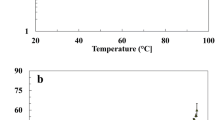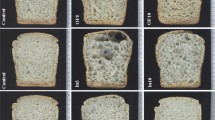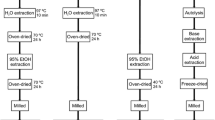Abstract
Gluten-free dough formulations were prepared based on maize flour with enhanced nutritional benefits due to addition of dietary fiber. Starting from a base formulation that consisted of maize flour, maize starch, dried eggs, and carrageenan, the influence of Psyllium, pea fiber, and oat bran on the rheological properties of dough at different water absorption levels was investigated. Dough cohesion was influenced by addition of dietary fiber due to the hydration properties of fibers. Starch pasting properties were also influenced by fiber addition and water levels. Improvements in the quality of gluten free-bread with glucose oxidase added to dough were evaluated. Glucose oxidase improved the specific volume of bread for all fiber types. Crumb firmness was improved only by addition of Psyllium and pea fibers.
Similar content being viewed by others
References
Mustalahti K, Catassi C, Reunanen A, Fabiani E, Heier M, McMillan S, Murray L, Metzger MH, Gasparin M, Bravi E, Maki M. The prevalence of celiac disease in Europe: Results of a centralized, international mass screening project. Ann. Med. 42: 578–595 (2010)
Dobru D, Pascu O, Tanta M, Gheorghe C, Goldis A, Balan G, Olteanu I, Fraticiu A, Dumitru E, Miutescu E, Mulder C, Podoleanu S. The prevalence of coeliac disease at endoscopy units in Romania: Routine biopsies during gastroscopy are mandatory (a multicentre study). Rom. J. Gastroenterol. 12: 97–100 (2003)
Schober TJ, Bean SR, Boyle DL, Park SH. Improved viscoelastic zein-starch doughs for leavened gluten-free breads: Their rheology and microstructure. J. Cereal Sci. 48: 755–767 (2008)
Torbica A, Hadnadev M, Dapcevic T. Rheological, textural and sensory properties of gluten-free bread formulations based on rice and buckwheat flour. Food Hydrocolloid. 24: 626–632 (2010)
Ziobro R, Witczak T, Juszczak L, Korus J. Supplementation of gluten-free bread with non-gluten proteins. Effect on dough rheological properties and bread characteristic. Food Hydrocolloid. 32: 213–220 (2013)
Mariotti M, Lucisano M, Ambrogina Pagani M, Ng PKW. The role of corn starch, amaranth flour, pea isolate, and Psyllium flour on the rheological properties and the ultrastructure of gluten-free doughs. Food Res. Int. 42: 963–975 (2009)
de la Hera E, Talegon M, Caballero P, Gomez M. Influence of maize flour particle size on gluten-free breadmaking. J. Sci. Food Agr. 93: 924–932 (2013)
Lazaridou A, Duta D, Papageorgiou M, Belc N, Biliaderis CG. Effects of hydrocolloids on dough rheology and bread quality parameters in gluten-free formulations. J. Food Eng. 79: 1033–1047 (2007)
Sciarini LS, Ribotta PD, Leon AE, Perez GT. Incorporation of several additives into gluten free breads: Effect on dough properties and bread quality. J. Food Eng. 111: 590–597 (2012)
Onyango C, Unbehend G, Lindhauer MG. Effect of cellulosederivatives and emulsifiers on creep-recovery and crumb properties of gluten-free bread prepared from sorghum and gelatinised cassava starch. Food Res. Int. 42: 949–955 (2009)
Renzetti S, Arendt EK. Efects of oxidase and protease treatments on the breadmaking functionality of a range of gluten-free fours. Eur. Food Res. Technol. 229: 307–317 (2009)
Renzetti S, Courtin CM, Delcour JA, Arendt EK. Oxidative and proteolytic enzyme preparations as promising improvers for oat bread formulations: Rheological, biochemical and microstructural background. Food Chem. 119: 1465–1473 (2010)
Witczak M, Juszczak L, Ziobro R, Korus J. Influence of modified starches on properties of gluten-free dough and bread. Part I: Rheological and thermal properties of gluten-free dough. Food Hydrocolloid. 28: 353–360 (2013)
Onyango C, Mutungi C, Unbehend G, Lindhauer MG. Modification of gluten-free sorghum batter and bread using maize, potato, cassava or rice starch. LWT-Food Sci. Technol. 44: 681–686 (2011)
Crockett R, Ie P, Vodovotz Y. Effects of soy protein isolate and egg white solids on the physicochemical properties of gluten-free bread. Food Chem. 129: 84–91 (2011)
Marco C, Rosell CM. Breadmaking performance of protein enriched, gluten-free breads. Eur. Food Res. Technol. 227: 1205–1213 (2008)
Matos ME, Sanz T, Rosell CM. Establishing the function of proteins on the rheological and quality properties of rice based gluten free muffins. Food Hydrocolloid. 35: 150–158 (2014)
Minarro B, Albanell E, Aguilar N, Guamis B, Capellas M. Effect of legume flours on baking characteristics of gluten-free bread. J. Cereal Sci. 56: 476–481 (2012)
Nunes MHB, Ryan LAM, Arendt EK. Effect of low lactose dairy powder addition on the properties of gluten-free batters and bread quality. Eur. Food Res. Technol. 229: 31–41 (2009)
Van Riemsdijk LE, van der Goot AJ, Hamer RJ, Boom RM. Preparation of gluten free bread using a meso-structured whey protein particle system. J. Cereal Sci. 53: 355–361 (2011)
Renzetti S, Dal Bello F, Arendt EK. Microstructure, fundamental rheology and baking characteristics of batters and breads from gluten-free flours treated with a microbial transglutaminase. J. Cereal Sci. 48: 33–45 (2008)
Cappa C, Lucisano M, Mariotti M. Influence of Psyllium, sugar beet fibre and water on gluten-free dough properties and bread quality. Carbohyd. Polym. 98: 1657–1666 (2013)
Sabanis D, Lebesi D, Tzia C. Effect of dietary fibre enrichment on selected properties of gluten-free bread. LWT-Food Sci. Technol. 42: 1380–1389 (2009)
Ronda F, Perez-Quirce S, Angioloni A, Collar C. Impact of viscous dietary fibres on the viscoelastic behaviour of gluten-free formulated rice doughs: A fundamental and empirical rheological approach. Food Hydrocolloid. 32: 252–262 (2013)
Bonnand-Ducasse M, Della Valle G, Lefebvre J, Saulnier JL. Effect of wheat dietary fibres on bread dough development and rheological properties. J. Cereal Sci. 52: 200–206 (2010)
ASRO. Romanian standards catalog for cereal and milling products analysis. SR 90, SR 91. Romanian Standards Association, National Standardizations Body, Bucharest, Romania (2008)
Dubat A, Boinot N. Mixolab Applications Handbook. Rheological and Enzymes Analyses. Chopin Technology, Villeneuve-la-Garenne, France. pp. 10–15, 148–149 (2012)
AACC. Approved Methods of the AACC. 10th ed. Method 74-09. American Association of Cereal Chemists, St. Paul, MN, USA (2000)
Kane AM, Lyon BG, Swanson RB, Savage EM. Comparison of two sensory and two instrumental methods to evaluated cookie color. J. Food Sci. 68: 1831–1837 (2003)
Rosell CM, Santos E, Collar C. Mixing properties of fibre-enriched wheat bread doughs: A response surface methodology study. Eur. Food Res. Technol. 223: 333–340 (2006)
Wagner MJ, Lucas T, Le Ray D, Trystram G. Water transport in bread during baking. J. Food Eng. 78: 1167–1173 (2007)
Ferrero C, Martino MN, Zaritzky NE. Effect of hydrocolloids on starch thermal transitions, as measured by DSC. J. Therm. Anal. 47: 1247–1266 (1996)
Author information
Authors and Affiliations
Corresponding author
Rights and permissions
About this article
Cite this article
Aprodu, I., Banu, I. Influence of dietary fiber, water, and glucose oxidase on rheological and baking properties of maize based gluten-free bread. Food Sci Biotechnol 24, 1301–1307 (2015). https://doi.org/10.1007/s10068-015-0167-z
Received:
Revised:
Accepted:
Published:
Issue Date:
DOI: https://doi.org/10.1007/s10068-015-0167-z




